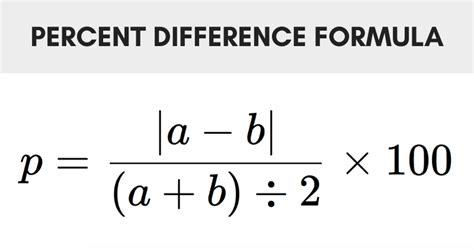How to Calculate Percent Difference: A Simple Guide
Calculating percent difference might seem daunting, but it's a straightforward process once you understand the formula and the nuances involved. This guide will walk you through different scenarios and offer tips for accurate calculations. Understanding percent difference is crucial in various fields, from finance and business to science and data analysis.
Understanding Percent Difference vs. Percent Change
Before diving into the calculations, it's important to distinguish between percent difference and percent change. While often confused, they represent different concepts:
-
Percent Difference: This measures the relative difference between two numbers, regardless of which is larger. It shows the magnitude of the difference between them as a percentage of their average. It's useful when comparing two unrelated values or when the order of the numbers doesn't matter.
-
Percent Change: This calculates the relative change between an initial value and a final value. It specifically shows the increase or decrease from the initial value as a percentage. It's commonly used to track growth or decline over time.
Calculating Percent Difference: The Formula
The formula for calculating percent difference is:
|Value 1 - Value 2| / ((Value 1 + Value 2) / 2) * 100%
Let's break it down:
-
Find the absolute difference: Subtract the smaller value from the larger value and take the absolute value (using the absolute value function denoted by | |, which means ignore the negative sign if there is one).
-
Calculate the average: Add the two values together and divide by two.
-
Divide the difference by the average: Divide the absolute difference by the average.
-
Multiply by 100%: Multiply the result by 100% to express it as a percentage.
Example Calculation
Let's say we want to find the percent difference between 25 and 30:
-
Absolute Difference: |25 - 30| = 5
-
Average: (25 + 30) / 2 = 27.5
-
Divide: 5 / 27.5 ≈ 0.1818
-
Multiply by 100%: 0.1818 * 100% ≈ 18.18%
Therefore, the percent difference between 25 and 30 is approximately 18.18%.
When to Use Percent Difference
Percent difference is ideal when:
- Comparing unrelated values: For instance, comparing the average temperature of two different cities.
- Focusing on the magnitude of difference: The direction of the difference (whether one value is larger or smaller) is less important than the size of the difference itself.
- Analyzing discrepancies: Determining the extent of variation between measured values.
Common Mistakes to Avoid
- Forgetting the absolute value: The absolute value is crucial; otherwise, you might get a negative percentage, which doesn't accurately represent the percent difference.
- Confusing it with percent change: Use the appropriate formula depending on whether you're comparing unrelated values or tracking changes over time.
- Incorrect order of operations: Always follow the order of operations (PEMDAS/BODMAS) to avoid calculation errors.
Mastering Percent Difference: A Valuable Skill
Understanding how to calculate percent difference is a fundamental skill with broad applications. By mastering this concept and avoiding common pitfalls, you'll be better equipped to analyze data, compare values, and interpret results effectively in various contexts. Remember to choose the correct calculation method (percent difference versus percent change) based on the specific problem you're trying to solve.
